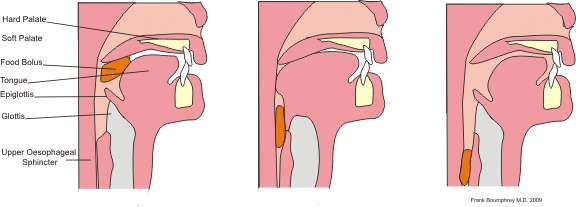The process of swallowing includes three phases. The soft palate rises to close off the superior nasopharynx.

Swallowing Phases Control Teachmephysiology
Phases of Swallowing 1.

. Three stages are involved in swallowing food. First week only 499. Swallowing also called Deglutition the act of passing food from the mouth by way of the pharynx or throat and esophagus to the stomach.
Food enters pharynx all routes except to digestion are blocked off the tongue blocks off the mouth the soft palet rises. Describe the two phases of swallowing. The swallowing process was classified into oral pharyngeal and esophageal stages according to the location of the bolus.
The dorsal body cavity and the ventral body cavity are two types of internal cavities found in the h. Swallowing is a very complex process. It requires the coordination of several nerves and muscle groups.
Voluntary stages of swallowing oral stages Infratentorial region of control is located in the brainstem medulla Infratentorial region controls involuntary stages of swallowing pharyngeal and esophageal Deglutition a series of complex neuromuscular functions involving structures of the oral cavity pharnyx larynx and esophagus. The first stagethe oral which swallowing is done voluntarily buccal takes place in the mouth. Swallowing is divided into two stages.
3 rows Swallowing is divided into three stages. Swallowing sometimes called deglutition in scientific contexts is the process in the human or animal body that allows for a substance to pass from the mouth to the pharynx and into the esophagus while shutting the epiglottisSwallowing is an important part of eating and drinkingIf the process fails and the material such as food drink or medicine goes through the trachea. The two stages are well made out especially when solids are swallowed.
Food and liquid is chewed and. Swallowing or Deglutition occurs in the Buccal and Pharyngeal-esophageal phases. Organs involvedtongue soft palate.
Swallowing occurs in two major phases. The mouth closes and the soft portion of the roof of the mouth soft palate rises so. The temporary cessation of breathing which occurs during swallowing is called deglutition apnea.
Thus in addition to directing food into the digestive tract the. Describe the two phases of swallowing. Oral Prepatory volitional and pleasurable 2.
A Buccal voluntary phase of swallowing. Oral phase Pharyngeal phase Esophageal phase Oral phase. Healthcare providers describe it in 3 phases.
Oral Preparatory Bolus Formation Phase Food shown in green has been softened and mixed with saliva and is sitting on the dorsum of the tongue Phase 2 Oral Transit Phase of the Swallow Also known as the oral propulsion or transit stage The food is moved back through the mouth with a front- to-back squeezing action. The oral phase can be divided into two subphases the oral preparatory and the oral transport phase Aviv. Solution for Describe the three phases of swallowing.
Find step-by-step Anatomy and physiology solutions and your answer to the following textbook question. Pharynx and larynx at rest during oral preparatory phase of swallowing Airway is open and nasal breathing continues Phase 2. The first begins in the mouth.
During this phase you chew your food to a size shape and consistency that can be swallowed. The presence of a bolus gathered at the tongue base triggers the sequence of reflexes collectively known as swallowing which propels the. 1 Phases of Swallowing.
The second stage the tongue is used to clean. Oral Transit Phase is where the tongue works to move the food back towards the throat. The two phases of swallowing are as follows.
Deglutition is divided into three stages. The pharyngeal stage hardly takes a second. There food is mixed with saliva for lubrication and placed on the back of the tongue.
The oral phase which includes the gathering of food movements within the oral cavity mastication and the formation of boluses of ingesta at the base of the tongue is under voluntary control. The process of swallowing also known as deglutition involves the movement of substances from the mouth oral cavity to the stomach via the pharynx and esophagus. This pathway shares anatomy with the airway.
Swallowing is an essential and complex behavior learned very early in development. 2 3 The oral stage was later subdivided into oral preparatory and oral propulsive stages and the four stage model was established. Activitiestongue compacts food into a bolus forces the bolus into the oropharynx via tongue contractions.
Oral and Pharynx phase. Differentiate and describe the three phases of stomach secretions. Oral phase voluntary movement of the bolus from.
The two phases of swallowing are the oral and the pharyngeal. The normal adult swallowing process occurs in four stages. The Oral Transit Phase of the Swallow A-P Transit of bolus.
Very often while swallowing liquids 1st and 2nd stages are merged into one called the buccopharyngeal stage ie. Deglutition - swallowing has 2 phases the buccal phase occurs in the mouth and is voluntary the tongue forces the bolus into the oropharynx the pharyngeal-esophageal phase of swallowing is controlled by the swallowing center in the brain stem and is involuntary. Start your trial now.
The foods which are ingested will undergo initial transformation through various processes. Once the bolus is prepared the tongue begins the anterior to posterior propulsion of the bolus for passage to the pharynx. Oral Preparatory Phase also known as the pre-oral stage involves the cognitive response to food and fluid and the.
2 Clinical Relevance Dysphagia.

Feeding And The Swallow Mechanism Physiopedia

Swallowing Reflex Phases And Overview Of Neural Control Animation Youtube

The 4 Stages Of Swallowing Biomechanics Bolus Movement Youtube

0 Comments